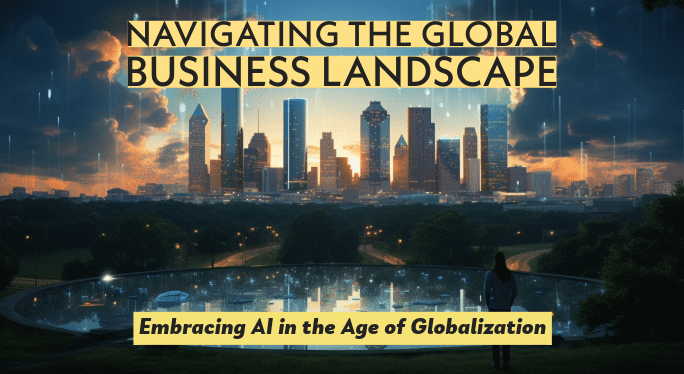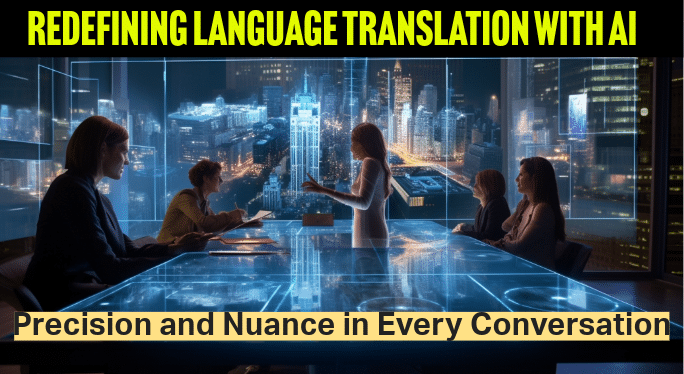
Introduction
In the age of globalization, businesses are no longer confined to geographical boundaries. As companies expand their horizons, venturing into international markets, they are met with a myriad of challenges. One of the most pronounced of these challenges is effective communication across diverse cultures and languages. While technology has bridged many gaps, language barriers in business persist, often leading to misunderstandings, misinterpretations, and missed opportunities. Current solutions, though helpful, only scratch the surface. This article delves into the potential of Artificial Intelligence (AI) in revolutionizing international business communications, going beyond mere language translation to encompass cultural and emotional intelligence.

The Role of AI in Overcoming Language Barriers
The digital era has witnessed remarkable advancements in AI-driven translation tools. Platforms like Google Translate and DeepL have made real-time translations accessible to the masses. However, business communications demand a level of precision and nuance that often eludes these tools.
Imagine a high-stakes business negotiation between a Japanese firm and a Brazilian startup. A simple phrase, when translated verbatim, might carry a different connotation in Japanese than in Portuguese. Herein lies the potential of advanced AI-driven translation tools. By integrating machine learning, natural language processing, and vast linguistic databases, these tools can achieve real-time translations that consider context, tone, and cultural nuances, drastically reducing the scope for errors.
Historical Context: Before the advent of digital translation tools, businesses relied heavily on human translators. This not only increased the time taken to finalize deals but also introduced human errors. With the introduction of platforms like Google Translate, businesses found a quicker way to bridge the language gap. Even today, these tools, are far from perfect. Misinterpretations are common, leading to humorous, and at times, costly mistakes. Over the years, with advancements in machine learning and natural language processing, the accuracy of these tools has improved significantly. But the question remains: Are they enough for the nuanced world of business communication?
Case Study: Consider the case of a U.S. company trying to market a new beverage in China. A direct translation of their tagline, meant to convey refreshment, instead suggested a medical benefit. The error led to confusion and a hurried rebranding effort. Such instances underline the importance of context and cultural understanding in translations.
Beyond Language: The Importance of Cultural and Emotional Intelligence
Language is just the tip of the iceberg when it comes to international business communications. Beneath the surface lie intricate layers of cultural norms, values, etiquettes, and emotional cues that play a pivotal role in shaping conversations.
Cultural intelligence refers to the ability to understand, relate, and adapt to different cultural contexts. It’s the skill that enables a businessperson from Europe to navigate a meeting in China, understanding the significance of hierarchy, the subtlety of indirect communication, and the importance of saving face.
Emotional intelligence, on the other hand, is the ability to recognize, understand, and manage our own emotions while recognizing and influencing the emotions of others. In a business setting, this translates to reading the room, understanding unspoken cues, and adapting communication styles accordingly.
The Iceberg Analogy: Think of culture as an iceberg. The visible tip represents the overt aspects of culture, like language, dress, and food. But beneath the surface lie deeper, covert elements like beliefs, values, and thought patterns. While language tools address the tip, the vast submerged portion remains uncharted.
Real-world Implications: In Japan, for instance, silence is an essential part of communication. It signifies respect, understanding, or even disagreement. A Western businessperson might misinterpret this silence as confusion or lack of interest. Such subtle cultural nuances play a crucial role in international business.

Envisioning an AI-Driven Meeting Management Tool
In a world where technology continually reshapes the way we conduct business, the concept of an AI-driven meeting management tool isn’t far-fetched. Such a tool wouldn’t just translate words; it would interpret the essence of conversations, ensuring that the intended message is conveyed with cultural and emotional accuracy.
- Real-time translation with cultural nuances: This feature would go beyond direct translations. By leveraging deep learning algorithms, the tool could understand context, idiomatic expressions, and cultural references, ensuring that the translated message retains its original intent.
- Localization services: Beyond just language, this component would adapt content to specific regions, considering local customs, beliefs, and values. For instance, a presentation for a German audience might be direct and data-driven, while one for an Indian audience might incorporate relationship-building anecdotes.
- AI-driven negotiation training and real-time feedback: Negotiations are a dance of words, expressions, and emotions. The tool could guide users in real-time, suggesting when to push, when to yield, and when to seek compromise. By analyzing historical data and cultural norms, it could offer insights like, “In Japanese business culture, it’s common to start with small talk before diving into the main agenda.”
- Building and maintaining long-term relationships: Relationships are the bedrock of business. The AI system could analyze communication patterns over time, suggesting strategies to strengthen bonds. For instance, if a client from South Korea mentions their love for golf, the tool could remind the user before the next meeting, suggesting it as a conversation starter.
Technical Specifications: The envisioned tool would be a blend of advanced algorithms and vast cultural databases. It would require constant updates, learning from every interaction to improve its accuracy. Integration with other business tools, like CRM systems, could provide context, making its suggestions even more precise.
User Experience: From a user’s perspective, the tool could be a simple app or a browser extension. As they type or speak, the tool would offer real-time feedback. It could highlight potential issues in red, suggest alternatives, or even provide a cultural context pop-up, explaining the rationale behind its suggestions.
Practical Applications and Scenarios
Imagine a scenario where a tech startup from Israel is pitching to investors in the UAE. Cultural and linguistic differences are vast. The AI tool, integrated into their presentation software, offers real-time feedback. When a slide contains a cultural reference unfamiliar to the Emirati audience, the tool suggests a more relatable analogy. During the Q&A, as an investor poses a question, the tool provides a translated transcription, along with context on the investor’s background and potential concerns.
In another scenario, a negotiation between a French wine distributor and a Chinese retailer is underway. As discussions heat up, the AI tool discreetly alerts the French team that their tone might be perceived as aggressive, suggesting a softer approach.
The Global Landscape: In today’s interconnected world, businesses from different continents collaborate daily. From tech startups in Silicon Valley partnering with manufacturers in Shenzhen to European fashion brands sourcing textiles from South Asia, cross-border interactions are the norm. Each of these interactions presents unique communication challenges.
Case Study – The Israeli Tech Startup: Israel, often dubbed the “Startup Nation,” is home to numerous tech startups aiming to make it big on the global stage. When an Israeli tech startup pitches to investors in the UAE, they’re not just selling a product; they’re bridging centuries of cultural history. The AI tool, in this scenario, does more than just translate Hebrew to Arabic or English. It understands the historical context, the sensitivities, and the aspirations of both parties. When the Israeli presenter uses a military analogy, common in a country with mandatory military service, the tool might suggest a more neutral analogy for the Emirati audience.
Case Study – The French Wine Distributor: Wine is more than just a beverage for the French; it’s a cultural heritage. When a French wine distributor negotiates with a Chinese retailer, they’re navigating a landscape where appreciation for French wine is growing but is seen through a different cultural lens. The AI tool recognizes these nuances. If the French distributor emphasizes the wine’s “terroir,” the tool might explain the concept to the Chinese retailer while suggesting the distributor emphasize the prestige of the wine, a concept more resonant in the Chinese market.

The Potential Benefits and Downsides
The advantages of such a tool are manifold. Communication becomes seamless, misunderstandings are minimized, and businesses can navigate international waters with newfound confidence. However, there are potential pitfalls. Over-reliance on technology might diminish human intuition and judgment. There’s also the risk of the tool misinterpreting nuances, leading to unintended consequences.
The Digital Revolution: The last two decades have seen a digital revolution. Businesses have adopted tools that seemed like science fiction not long ago. Video calls, cloud storage, and digital currencies are now everyday tools. The proposed AI-driven tool is the next step in this evolution, offering benefits that can revolutionize international business communication.
The Ethical Dimension: However, with great power comes great responsibility. Relying heavily on an AI tool can lead to a loss of human touch in communications. There’s also the risk of the tool making an error with significant consequences. Moreover, there are concerns about data privacy. How would the tool store and use the vast amounts of data it processes? Ensuring ethical use would be paramount.
The Road Ahead: How Close Are We?
The integration of AI into our daily lives has been swift and transformative. From voice assistants like Siri and Alexa to recommendation engines on streaming platforms, AI’s footprint is undeniable. In the realm of business communication, the seeds have been sown, but there’s a journey ahead.
- Current Technological Advancements: Real-time translation tools are becoming increasingly sophisticated. Platforms like Google’s AutoML Translation allow businesses to create custom translation models tailored to their needs. Chatbots, powered by AI, are now commonplace on websites, assisting users in multiple languages and adapting responses based on user behavior.
- Challenges Ahead: The primary challenge lies in integrating cultural and emotional intelligence into AI systems. While machine learning models can be trained on vast datasets, human emotions and cultural nuances are intricate and ever-evolving. There’s also the ethical dimension: How much should we rely on machines in shaping human interactions? And how do we ensure that these tools are unbiased and respectful of all cultures?
- Potential Timeline: Given the current pace of technological advancement, a rudimentary version of the envisioned tool could be a reality within the next 5-7 years. However, a fully integrated, culturally and emotionally intelligent system might take a decade or more.
The Pace of Innovation: The tech world moves at a breakneck speed. Innovations that seemed years away are now realities. Given the advancements in AI, machine learning, and natural language processing, the foundation for our envisioned tool is already in place.
Collaboration is Key: However, building this tool isn’t just a tech challenge; it’s a collaborative effort. Linguists, cultural experts, historians, and ethicists need to work alongside tech experts. Such a multidisciplinary approach is essential to ensure the tool is accurate, sensitive, and ethical.
Conclusion
The world of international business is a tapestry of languages, cultures, and emotions. As businesses strive to navigate this complex landscape, the promise of AI looms large. The vision of an AI-driven meeting management tool, equipped not just with linguistic prowess but also cultural and emotional intelligence, is tantalizing.
However, technology is only as effective as its human users. While AI can guide, suggest, and assist, the onus remains on business leaders, managers, and professionals to approach cross-cultural interactions with an open mind, empathy, and respect.
The future beckons a collaborative effort. Tech companies, armed with AI expertise, need to partner with cultural experts, linguists, and businesses to bring this vision to life. The potential rewards — deeper understanding, stronger business relationships, and a truly global business community — are worth the endeavor.
The Global Village: Marshall McLuhan’s concept of the world as a “global village” is more relevant today than ever. As businesses operate in this global village, tools that help them communicate effectively are invaluable. The envisioned AI tool isn’t just another piece of software; it’s a bridge between cultures, a facilitator of mutual understanding, and a harbinger of a truly interconnected world.
The Human Element: While we advocate for the adoption of advanced tools, we mustn’t lose sight of the human element. Technology should aid human interaction, not replace it. As we stand on the cusp of this exciting innovation, let’s pledge to use it responsibly, ethically, and in a manner that brings us closer together.
For businesses operating on the global stage, the message is clear: Stay informed, be adaptable, and embrace the potential of AI. For tech innovators, the challenge is to push the boundaries of what AI can achieve, always with an eye on ethical considerations. And for all of us, the goal is to work towards a world where language and culture enrich our interactions, rather than impede them.
